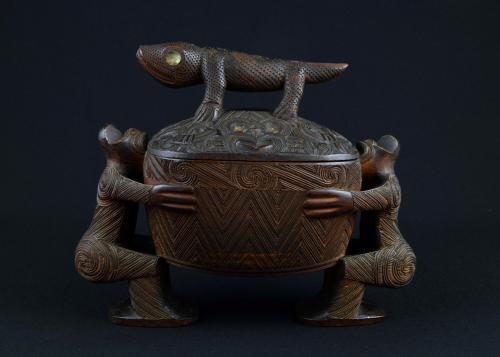
The gigantic kawekaweau is surrounded by great myth

Fuelling rumours that a gecko as long as your arm lived in Aotearoa until the late 1800s is an antique taxidermied gecko in the Musée d’Histoire Naturelle in Marseille, France.
This specimen has been steeped in mystery since its rediscovery in 1870. However, in June this year, DNA from the specimen proved it’s probably a relative of New Caledonian geckos - not as previously thought, a member of Hoplodactylus delcourti, a species endemic to New Zealand.
Enigmatically however, a few vivid anecdotes were also compelling enough to have supported the premise that a giant gecko or kawekaweau had actually lived in Aotearoa.
Addressing the Wellington Philosophical Society in 1870 (around the time the French specimen was rediscovered), Walter Buller noted the presence of a beautiful striped lizard attaining two feet in length that lived in the forests north of Auckland. Buller also mentioned a man in Hokianga had obtained a pair of the lizards, but that “unfortunately one had been eaten by a cat and the other made its escape.”
Another story a couple of years later, had an Urewera rangatira noting a kawekaweau under a dead rata in the Waimana valley. This reptile “was about two foot long, as thick as a man’s wrist; coloured brown [and] striped longitudinally with dull red.”
Most certainly the gigantic kawekaweau is surrounded by great stories – including that Kahungunu himself kept one in an oversized box, only to open it for gullible friends and family, giving them a terrific fright.
Interestingly, about the same time as the famed Hoplodactylus delcourti was brought to life by these reported sightings, ngārara / lizards appeared more regularly in architectural and decorative art works by Māori.
And, while ngārara forms still appear in Māori art works infrequently, they appear to be significant when they do. In 1906 Te Arawa master carver Tene Waitere incorporated ngārara in a poutukomanawa for the house Rangitihi held at Auckland Museum and ngārara forms appear on other Te Arawa houses named for the eponymous leader of Ngāti Rangitihi.
On this kumete, from the Hawke’s Bay Museums Trust collection, a ngārara keeps watch, guarding precious objects inside. Although quite huge when compared to the figures holding the kumete aloft, like a harmless gecko, the protecting creature appears to be in service, a friendly guard dog.
Carvings such as this were made for the commercial market, which was really taking off In the 1870s, and the centre of that market was Rotorua, where tourist attractions drew the crowds and entrepreneurial artisans seized the day.
But it was not only travelling Europeans who were commissioning pieces, many works went to Māori patrons also. Another form of customer was the avid, sometimes not so ethical, Pākeha collector. One such collector was Gilbert Mair, the brother of Major William Gilbert Mair (whose 1872 report recorded the Urewera rangitira’s sighting of the last of the kawekaweau).
Like the gecko specimen held in the museum in France, the kumete in the photo has no information on its origin.
I like to fancy that the appearance of such a large reptilian character on its lid is a creative response to new knowledge of the day. That late into the evenings the Mair brothers, one a naturalist, the other an avid art collector talked at length of their specialist interests. And that in this way, the story of the mysterious kawekaweau passed from naturalist to art collector and in turn the local art scene where stories of the rare gigantic lizard were stylised into pieces such as this one.
And this may be the case, but is likely as fanciful as the now debunked myths that surrounded the kawekaweau in the first place. Either way, it is fascinating to ponder the contexts in which art works as beautiful as this have been realised.
You can see the kumete in Eye Spy: Curious Stories at MTG Hawkes Bay. Free Entry.
Published in the Hawke’s Bay Today newspaper 7 October 2023 and written by Toni MacKinnon, Art Curator at MTG Hawke’s Bay.
Image: Kumete, (circa 1800s), on loan from Shrimpton Collection, Hawke’s Bay Museums Trust, Ruawharo Tā-ū-rangi 61/104
13 October 2023



